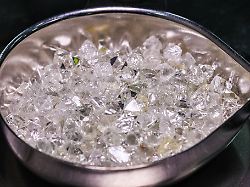Import bans imposed
EU gives Russia diamonds and liquid gas
December 18, 2023, 6:34 p.m
Almost 22 months after the start of the Russian attack on Ukraine, the twelfth sanctions package follows. This time the EU is targeting the war chest even more sharply and wants to restrict the Russian diamond trade – as well as liquid gas deliveries.
Russian diamonds and diamond jewelry will no longer be allowed to be imported into the European Union in the future. The 27 member states decided on a corresponding import ban as part of the twelfth sanctions package due to the Russian war of aggression against Ukraine. It is intended to deprive the government in Moscow of an important source of income and thus also limit the ability to finance the war against Ukraine.
The EU Commission recently estimated Russia’s income from the sale of diamonds at around four billion euros per year. According to the decision, the import ban will apply from January 1st to diamonds coming directly from Russia. By September 1st, Russian diamonds and jewelry products processed in third countries such as India must be gradually banned from the market. To ensure effectiveness, a testing and certification system for rough diamonds is to be set up within the group of seven western industrialized countries (G7) in order to trace the origin of the diamonds.
In addition to the diamond ban, the twelfth EU sanctions package plans to tighten the price cap for Russian oil exports to third countries, which has recently had little effect. There are also trade restrictions on other goods and punitive measures against people and organizations that support the Russian war of aggression. Specifically, this involves, for example, a ban on imports of raw materials for steel production, processed aluminum products and other metal goods, as well as export restrictions on goods such as lithium batteries, thermostats and certain chemicals. There is also a new import ban on liquefied petroleum gas (LPG) from Russia, which, according to the Commission, affects imports of more than one billion euros per year. According to a grandfather clause, existing contracts should also be affected after a maximum of twelve months.
Billion dollar diamond deals
The reason why a ban on the import of Russian diamonds was only now decided was, among other things, the initial resistance from Belgium. The Flemish port city of Antwerp has been one of the world’s most important diamond centers since the 16th century. Russia is considered the world’s largest producer of rough diamonds. In 2021, the state diamond miner Alrosa had revenues of 332 billion rubles (around 3.4 billion euros).
In addition to the economic punitive measures, according to the EU, sanctions are planned against more than 140 other people and organizations that support the Russian war of aggression against Ukraine. They would then no longer be able to dispose of assets existing in the EU. The affected people will also no longer be allowed to enter the EU. For example, they are said to come from the Russian military, defense and IT sectors. The last package of sanctions to date came into force in June. For example, it included an instrument against the circumvention of sanctions that have already been imposed. There has long been a far-reaching import ban on crude oil, coal, steel, gold and luxury goods, as well as punitive measures against banks and financial institutions.
In order to improve the effectiveness of the oil price cap, the monitoring measures and documentation requirements are planned to be tightened. In the future, it could become more difficult for shipping companies to participate in circumventing Russia sanctions with impunity. The price cap came into force about a year ago together with a far-reaching ban on the import of Russian oil into the EU. It is actually intended to force Russia to sell oil to buyers in other countries for a maximum of 60 US dollars per barrel (159 liters).
Shadow fleet in sight
However, according to researchers at the Kyiv School of Economics, recent data suggested that more than 99 percent of Russian crude oil exported by sea in October was sold at a price of more than $60 (56 euros) a barrel . This is probably possible because fake price certificates are provided, they write. In addition, Russia could increasingly rely on a “shadow fleet,” i.e. ships that are not owned by Western shipping companies or not insured by Western insurance companies. In order to enforce the price cap for exports to non-EU countries, it was decided that maritime transport services important for Russian oil exports could only be provided with impunity if the price of the exported oil did not exceed the price cap.
Western shipping companies can continue to use their ships to transport Russian oil to countries such as India, China or Egypt. The regulation also applies to other important services such as insurance, technical assistance and financing and brokerage services.
The hope is that the price cap will lead to relaxation on the energy markets in the long term and will also relieve pressure on third countries. In addition, it should be ensured that Russia can no longer benefit from increases in oil prices and thus fill its war chest.
The last package of sanctions to date came into force in June. For example, it included an instrument against the circumvention of sanctions that have already been imposed. There has long been a far-reaching import ban on crude oil, coal, steel, gold and luxury goods, as well as punitive measures against banks and financial institutions.
